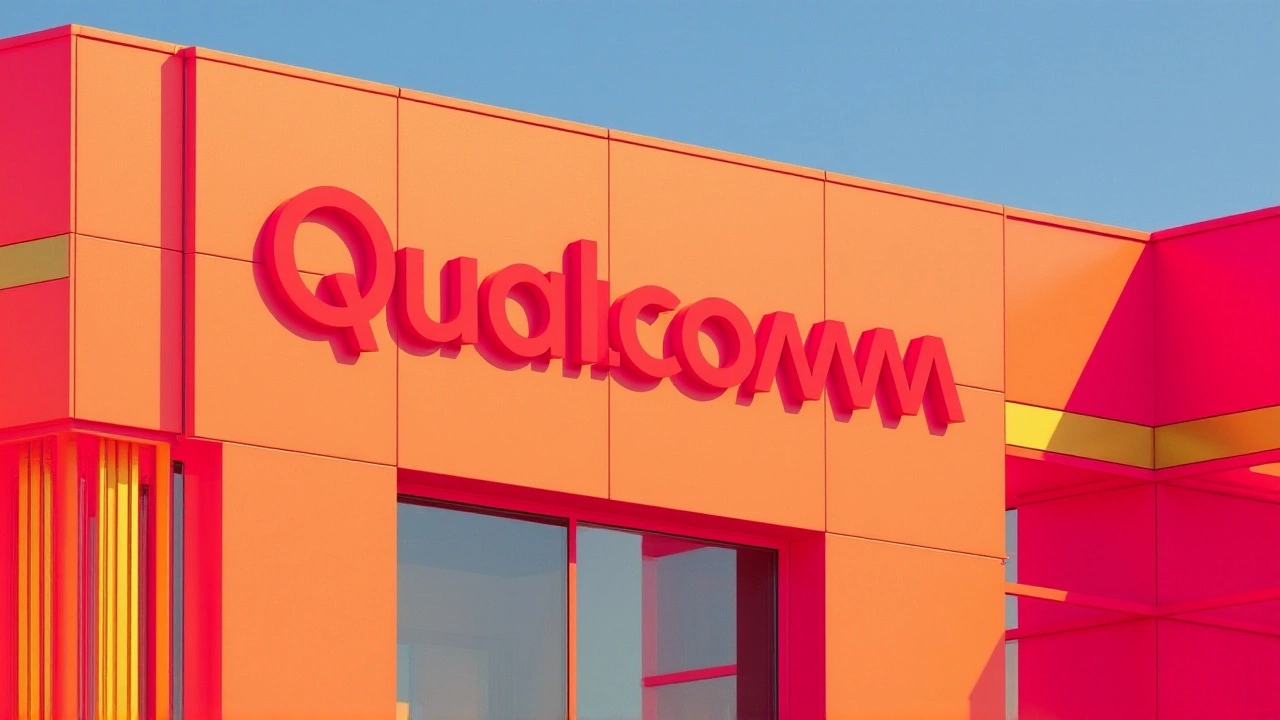Qualcomm Unveils AI200 and AI250 Chips to Challenge Nvidia’s AI Dominance
 Oct, 28 2025
Oct, 28 2025
On October 27, 2025, Qualcomm Incorporated dropped a bombshell in the AI hardware world: two new inference chips, the AI200 and AI250, designed not just to compete with Nvidia Corporation—but to upend its 80% grip on the data center AI market. The announcement came during a press conference at Qualcomm’s global headquarters in San Diego, California, where executives revealed chips engineered for one thing: doing more AI work with less power, less cost, and less friction. Investors didn’t wait. By the end of extended trading that day, Qualcomm’s stock jumped nearly 15% to $182.23 on the NASDAQ. This wasn’t just another product launch. It was a declaration of war.
Breaking Nvidia’s Hold, One Watt at a Time
For years, Nvidia Corporation has ruled the AI accelerator market like a monarch. Its H100 and Blackwell GPUs power nearly every major AI training and inference pipeline—from OpenAI to Amazon Web Services. But the cost is staggering: $30,000 to $40,000 per chip, plus electricity bills that rival small towns. Energy consumption now accounts for nearly 40% of total data center operating expenses. That’s where Qualcomm sees its opening. The AI200, launching in Q2 2026, packs 768GB of LPDDR memory per PCIe card, optimized for large language models (LLMs) like GPT-4 and Claude 3. But the real headline is the AI250, due in Q4 2027. It uses a breakthrough near-memory computing architecture Qualcomm claims delivers 10x bandwidth gains over current standards. That means less time waiting for data to travel from memory to processor—and far less energy wasted in the process. "It’s not about raw TOPS," said one engineer familiar with the design. "It’s about how efficiently you move data. And Qualcomm finally built a chip that doesn’t beg for bandwidth—it just has it."A Strategic Web of Partnerships and Acquisitions
Qualcomm didn’t get here by accident. The company’s pivot into data center AI has been years in the making. In 2023, it bought Israeli startup Hailo Technologies for $900 million, gaining critical AI inference IP. Then came the $2.4 billion acquisition of Alphawave Semi in Q3 2025—a move that gave Qualcomm high-speed connectivity tech critical for rack-scale deployments. But the most surprising twist? A partnership with Nvidia Corporation itself. Yes, you read that right. Qualcomm and Nvidia are collaborating on NVLink integration. This means future AI200 and AI250 chips will work seamlessly with existing Nvidia GPU clusters. It’s a tactical masterstroke: instead of forcing customers to rip out their $10 billion GPU farms, Qualcomm is offering a plug-and-play upgrade path. "They’re not trying to replace Nvidia’s ecosystem," noted Daniel Nenni, Admin and Staff member at SemiWiki. "They’re letting customers keep their software investments while lowering their TCO. That’s how you win in enterprise.""
Global Validation: Saudi Arabia’s Bet on Qualcomm
Early market validation came fast. Just hours after the announcement, Humain, an AI infrastructure firm based in Riyadh, Saudi Arabia, announced it would deploy Qualcomm’s chips across 200 megawatts of data center capacity. That’s enough to power roughly 150,000 homes—and it’s just the first phase. For a company that spent decades building chips for smartphones, landing a Middle Eastern sovereign-backed infrastructure deal of this scale is monumental. It signals that global investors are betting Qualcomm can scale beyond consumer devices.The Three-Way Battle Ahead: Qualcomm, Nvidia, and Intel
But Qualcomm isn’t just fighting Nvidia. Intel Corporation is preparing its own counterattack with the Crescent Island data center AI chips, set to arrive in Q3 2026. Intel’s advantage? Deep ties to enterprise IT departments and decades of x86 compatibility. Qualcomm’s edge? Power efficiency. And software flexibility. While Nvidia’s CUDA ecosystem remains a fortress, Qualcomm’s open, modular architecture could appeal to cloud providers tired of vendor lock-in. The AI inference market is projected to hit $200 billion by 2030. Qualcomm’s goal? Capture even 10% of that—and it’s already worth $20 billion in annual revenue. But here’s the catch: software matters more than silicon. If developers can’t easily port their models to Qualcomm’s platform, the hardware won’t matter. The company has partnered with Microsoft Azure to optimize Windows on Snapdragon for AI, but that’s just the start. They’ll need a full-stack ecosystem: compilers, libraries, model optimization tools. And they’ll need them fast.
What’s Next? The Race for the Edge and the Cloud
The AI200 targets enterprise inference—think customer service bots, real-time translation, medical imaging analysis. The AI250? That’s for the next frontier: trillion-parameter models running at scale. If Qualcomm delivers on its 10x bandwidth promise, it could make inference as affordable as training is today. That’s revolutionary. Looking ahead, expect Qualcomm to push deeper into automotive AI, IoT edge devices, and even quantum-classical hybrid systems. Its CEO, Cristiano Amon, has been clear since 2024: Qualcomm isn’t just a mobile chipmaker anymore. It’s becoming the infrastructure layer for the AI era.Frequently Asked Questions
How do Qualcomm’s AI200 and AI250 chips compare to Nvidia’s H100 in power efficiency?
Qualcomm claims the AI200 delivers comparable LLM inference performance to the H100 while consuming 40% less power, thanks to its optimized Hexagon NPU and LPDDR memory architecture. The AI250’s near-memory computing design reportedly cuts energy use by up to 60% compared to current GPU-based systems, making it far more viable for large-scale deployments where cooling and electricity costs dominate budgets.
Why did Qualcomm partner with Nvidia, its biggest competitor?
The NVLink integration allows customers to gradually adopt Qualcomm’s chips without abandoning existing Nvidia GPU infrastructure. This lowers adoption barriers, reduces migration risk, and makes Qualcomm’s hardware more attractive to enterprises already invested in CUDA. It’s a strategic compromise: Qualcomm gains access to Nvidia’s ecosystem, while Nvidia retains revenue from its installed base.
What’s the significance of Humain’s 200-megawatt commitment?
Humain’s deal isn’t just a sale—it’s validation. Deploying 200 megawatts of Qualcomm AI chips means the company has proven its hardware can scale reliably in real-world, high-density environments. For a startup in the data center space, this kind of sovereign-backed infrastructure commitment is rare and signals strong confidence in Qualcomm’s long-term viability.
Can Qualcomm overcome Nvidia’s CUDA software dominance?
It’s the biggest hurdle. CUDA has over a decade of developer adoption, libraries, and tools. Qualcomm is building its own software stack with Microsoft Azure and open-source partners, but it’ll need major AI frameworks like PyTorch and TensorFlow to offer native support. Without it, even the best hardware will sit idle. The next 18 months will determine whether Qualcomm can turn its hardware advantage into software momentum.
When will these chips be available in cloud data centers?
The AI200 is scheduled for commercial release in Q2 2026, with early access likely through select cloud providers by late 2025. The AI250, with its advanced near-memory design, won’t arrive until Q4 2027. Major hyperscalers like Google Cloud and AWS are expected to test prototypes in 2026, but full-scale adoption won’t happen until 2027–2028.
How does this affect the future of AI in small businesses?
If Qualcomm delivers on its TCO promises, AI inference could become affordable enough for SMBs to run models locally instead of paying cloud fees. A $5,000 AI200-based server might replace a $30,000 GPU rig, making real-time translation, document analysis, and customer AI tools accessible to companies that currently can’t afford the cloud. That’s the real disruption.